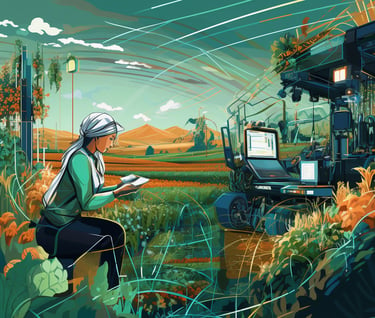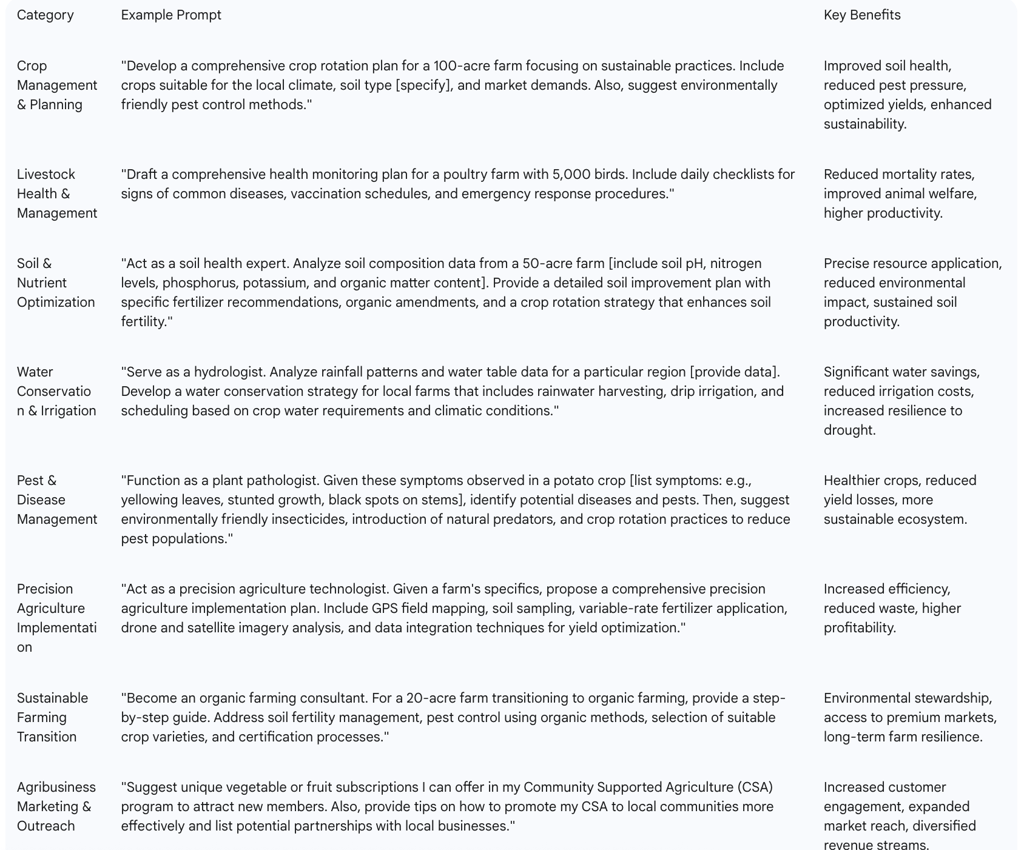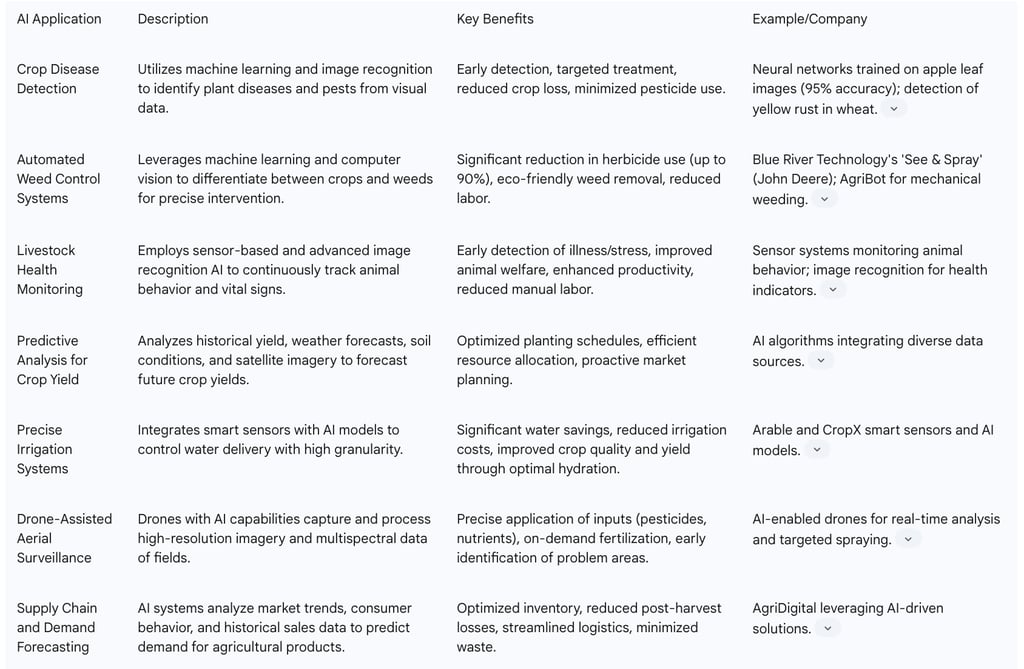Grow Smart: 8 Agriculture Prompts
Explore 8 powerful prompts tailored for the Agriculture Industry. Discover how AI can revolutionize farming and boost productivity.


The agricultural sector stands at the precipice of a profound transformation, driven by the rapid advancements in Artificial Intelligence (AI). This digital revolution offers unprecedented opportunities to enhance efficiency, bolster sustainability, and refine decision-making across the entire spectrum of farming operations. Within this evolving landscape, conversational AI, exemplified by tools like ChatGPT, emerges as a pivotal technology, ushering in a new era of "Grow Smart" agriculture. This report delves into the practical utility of ChatGPT for farmers and agribusiness professionals, presenting eight essential prompts designed to optimize various facets of modern farming.
I. Executive Summary
The agricultural sector is undergoing a significant digital transformation, with Artificial Intelligence (AI) emerging as a pivotal technology. AI offers unprecedented opportunities to enhance efficiency, sustainability, and decision-making across various farming operations. This report highlights how AI, particularly conversational AI like ChatGPT, is revolutionizing traditional practices, moving towards a "Grow Smart" paradigm.
ChatGPT, a powerful large language model, serves as an accessible and versatile tool for farmers and agribusiness professionals. It can act as a virtual consultant, providing instant access to vast agricultural knowledge, assisting with complex planning, and offering data-driven suggestions for critical decisions like crop selection or pest management strategies. Its conversational interface lowers the barrier to adopting advanced analytical capabilities.
This report presents eight meticulously crafted ChatGPT prompts, categorized to address key areas of modern agriculture. These prompts are designed to be immediately actionable, offering practical solutions for challenges ranging from optimizing crop yields and managing livestock health to implementing sustainable practices and streamlining agribusiness operations. Each prompt serves as a gateway to unlocking specific benefits, such as improved resource efficiency, enhanced productivity, and more resilient farming systems.
II. Introduction to AI in Agriculture: Cultivating Innovation
The integration of Artificial Intelligence into agriculture signifies a monumental shift, moving traditional farming practices towards a more data-driven, precise, and sustainable future. This section explores the nature of ChatGPT and its direct relevance to the agricultural sector, alongside the broader impact of AI technologies that are reshaping how food is produced.
What is ChatGPT and its Relevance to the Agricultural Sector
ChatGPT, developed by OpenAI, is a natural language processing tool that enables human-like conversations with an AI model. It belongs to a class of powerful Large Language Models (LLMs) capable of understanding, generating, and processing human language with remarkable fluency. The core relevance of ChatGPT to agriculture lies in its capacity to process immense volumes of information, synthesize diverse data sets, and generate tailored advice or comprehensive plans based on specific user inputs. This makes it an invaluable resource for knowledge acquisition and decision support within the complex and data-rich environment of modern farming.
For farmers, ChatGPT, along with other AI chatbots such as Bard, Bing Chat, Claude AI, and Poe, offers a direct and interactive gateway to specialized agricultural knowledge and problem-solving capabilities. The conversational interface of these tools significantly broadens access to sophisticated agricultural knowledge and decision-support capabilities. Historically, such high-level insights were often the domain of specialized consultants or required mastery of complex analytical software. Now, by simply asking questions and receiving actionable advice on intricate topics like soil improvement plans based on detailed data, these AI tools effectively translate advanced agricultural science and data analysis into an accessible format. This accessibility lowers the barrier to entry for advanced agricultural practices, empowering more farmers, regardless of their technical proficiency, to leverage AI for informed decision-making, thereby broadening access to expert-level agricultural insights.
The Broader Impact of AI on Traditional Farming Practices
The agricultural sector is increasingly embracing AI solutions, with approximately 60% of farms now turning to AI for assistance. This widespread adoption signals a definitive move from traditional, often intuition-based, farming methodologies to more data-driven and precision-oriented approaches. AI's influence permeates the entire agricultural value chain, leading to enhanced efficiency, greater sustainability, and more informed strategic choices.
Key applications of AI that are revolutionizing farming include:
Crop Disease Detection: AI systems, employing machine learning and image recognition, can identify crop diseases with remarkable accuracy. For instance, a neural network trained on apple leaf images achieved 95% accuracy in disease identification, and similar systems are effective in detecting issues like yellow rust in wheat crops. This capability facilitates timely interventions, leading to healthier crops and optimized yields.
Automated Weed Control Systems: AI-driven solutions are transforming weed management. Systems like Blue River Technology's 'See & Spray,' now part of John Deere, utilize high-resolution cameras and AI algorithms to precisely differentiate between crops and weeds. This allows for targeted herbicide application, reducing chemical usage by up to 90%. Advanced agricultural robots, such as AgriBot, leverage computer vision and image recognition to identify and mechanically eliminate weeds without harming surrounding crops, offering an eco-friendly alternative.
Livestock Health Monitoring: AI technology is revolutionizing animal health monitoring in the livestock industry. By deploying sensor-based and advanced image recognition systems, farmers can continuously monitor animal health indicators, moving beyond labor-intensive manual observations. This proactive monitoring helps identify critical health issues early, improving animal welfare and productivity.
Predictive Analysis for Crop Yield: AI algorithms integrate vast amounts of data, including soil moisture levels, climatic conditions, and specific crop demands, to accurately forecast crop yields. This predictive capability aids farmers in optimizing resource allocation, planning planting schedules, and making more informed market decisions.
Precise Irrigation Systems: Companies like Arable and CropX have introduced smart sensors and AI models that precisely control the amount of water delivered to each plot of land. By integrating data from various sources, these systems ensure crops receive optimal hydration, significantly reducing water waste and promoting sustainable agricultural practices while improving crop yield and quality.
Drone-Assisted Aerial Surveillance: Drones equipped with advanced AI capabilities are executing spraying tasks with unprecedented precision. By conducting in-depth, real-time analyses of agricultural imagery, these drones pinpoint areas needing attention and adjust spraying volumes for pesticides or nutrients based on actual crop needs, achieving true on-demand fertilization and pest control.
Supply Chain and Demand Forecasting: AI systems analyze extensive market data to accurately predict demand for agricultural products. This capability assists agricultural businesses in efficiently managing resources and inventory. Companies like AgriDigital are leveraging AI-driven solutions to streamline the entire supply chain process, ensuring timely resource distribution and significantly reducing waste.
The prevalence of prompts focused on sustainable farming practices suggests that AI is not merely a tool for enhancing efficiency but also a critical enabler for the widespread adoption and optimization of eco-friendly methods. The complexities of integrating diverse sustainable practices, such as cover cropping, composting, and integrated pest management, can often feel overwhelming to farmers. However, AI's ability to break down these complex practices into actionable prompts and generate tailored plans directly addresses this challenge. By providing clear pathways and step-by-step guidance, AI makes sustainable practices less daunting and more achievable, thereby accelerating the transition to and optimizing the implementation of sustainable agricultural methods, which contributes significantly to environmental health and long-term farm viability.
III. Mastering Prompt Engineering for Agricultural Success
The effectiveness of AI tools like ChatGPT in agricultural applications hinges significantly on the quality of the prompts provided. Crafting effective prompts is a skill, often referred to as prompt engineering, that unlocks the full potential of these conversational AI models.
Key Principles for Crafting Effective ChatGPT Prompts
To elicit the most accurate and useful responses from ChatGPT, adherence to several key principles of prompt engineering is essential:
Clarity: Prompts must be unambiguous and straightforward. Vague language should be avoided to prevent misinterpretations by the AI.
Context: Provide sufficient background information to help ChatGPT understand the specific scenario. For instance, instead of a generic "plan for crops," a more effective prompt would be "plan for corn crop rotation on a 100-acre farm with clay soil in a temperate climate".
Specificity: Detail precisely what is desired from the AI. This includes specifying crop type, farm size, local climate, soil type, and desired outcomes. An example might be, "Create a detailed guide for organic farming practices suitable for [specific crop type]".
Desired Output Format: Clearly state how the information should be presented. This could involve requesting a step-by-step process, a table, an outline, an email, or a specific length. For example, "Present the information in a table" or "Give me a step-by-step process for XYZ".
Include Examples (if applicable): Incorporating examples within the prompt can further guide the AI toward the intended output.
Define Role/Persona: Instructing ChatGPT to "Act as a soil health expert" or "Serve as a hydrologist" can significantly enhance the quality and relevance of the response by aligning the AI's output with a specific professional perspective.
Tips for Maximizing ChatGPT's Value in Diverse Farming Scenarios
Beyond the core principles, several practical tips can further maximize ChatGPT's utility in various agricultural contexts:
Iterative Refinement: Begin with a broad prompt and progressively refine it with follow-up questions. Adding more detail and context based on initial responses can lead to increasingly precise and valuable outputs.
Leverage Farm-Specific Data: Whenever possible, integrate specific farm data—such as soil test results, rainfall patterns, or observed crop symptoms—directly into prompts. This allows for highly tailored advice. For example, "Given the following soil test results [list soil nutrient data] from a vineyard, create a customized nutrient management plan".
Explore Different AI Tools: While ChatGPT is a leading platform, other chatbots like Bard, Bing Chat, Claude AI, or Poe can also be used with similar prompts, offering flexibility and potentially varied insights.
Understand Limitations: It is important to recognize that AI tools generate information based on their training data and may not possess real-time, hyper-local data. Human oversight and validation of AI-generated advice are crucial, especially for critical farm decisions.
The emphasis on detailed, contextual, and structured prompts suggests that effective interaction with AI is becoming a critical skill in modern agriculture. This transforms the farmer's role from purely operational to one that includes a degree of "AI guidance" or "data interpretation." The fact that simply knowingwhat to ask is insufficient, and that the quality of the AI's output directly correlates with the quality and specificity of the input prompt, means farmers need to learn how to articulate their needs and data in a way that AI can effectively process. This skill is not merely a technicality but a strategic capability, enabling farmers to extract maximum value from AI, turning a generic AI into a highly specialized agricultural assistant. As AI becomes more integrated into farming, the ability to effectively communicate with and guide AI models will become as important as understanding soil types or machinery maintenance, representing a fundamental shift in the skill set required for modern agricultural success, adding a cognitive and analytical dimension to traditional farming expertise.
Furthermore, the requirement for farmers to provide specific data and the implicit understanding of AI's limitations highlight that AI is an augmentative tool, not a replacement for human expertise and real-time farm conditions. Many prompts necessitate the user to "include soil nutrient data," "provide data" for rainfall patterns, or "list symptoms" for disease identification. This means the AI's advice is only as valuable as the farm-specific data provided by the farmer. The AI's responses are based on its training data and the specific input it receives; it does not inherently "know" the unique microclimate, soil variations, or specific pest pressures of an individual farm without explicit data. Therefore, the farmer's role in supplying accurate, real-time data and critically evaluating the AI's output is paramount. This indicates that precise, farm-specific data input leads to more relevant and actionable AI outputs. Conversely, relying solely on generic AI advice without local context or human validation could lead to suboptimal or even detrimental decisions. AI in agriculture functions best as a sophisticated advisory system that enhances human intelligence and local knowledge, underscoring the continued necessity of the farmer's expertise, observational skills, and critical judgment to integrate AI insights effectively with the unique realities of their farm.
IV. 8 Essential ChatGPT Prompts for Smart Agriculture
This section details eight practical ChatGPT prompts, each meticulously designed to address a specific area of agricultural management. These prompts serve as actionable examples, demonstrating how farmers can effectively leverage conversational AI for improved decision-making and operational efficiency.
To provide a quick reference, the following table summarizes these eight prompts, categorizing them by their primary application, offering an example prompt, and highlighting their key benefits.
Table 1: Key ChatGPT Prompts for Agriculture




